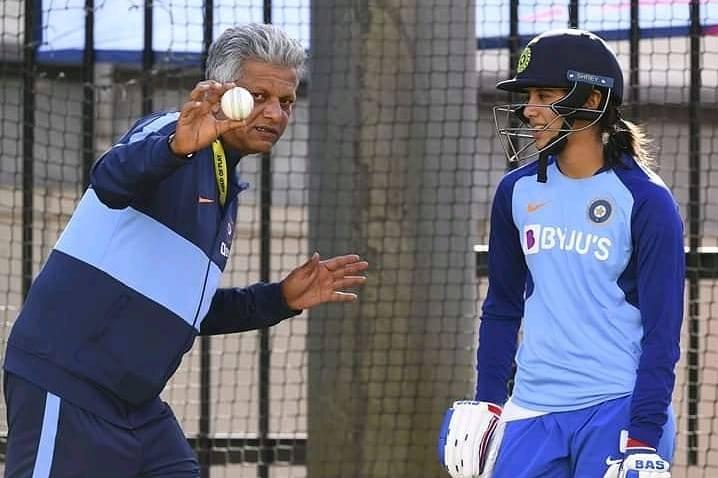
WV Raman, former India opener, had a successful time as the coach of the India women’s team. During his tenure, India defeated England, South Africa and West Indies in ODIs. They also reached the final of the T20 World Cup in Australia (2020). With India about to embark on another T20 World Cup campaign, the calm and collected Raman opened up on a variety of topics, ranging from their chances at the mega event to any areas of concern and his thoughts on some of the mainstays of the set-up, including Smriti Mandhana and Harmanpreet Kaur.
Excerpts from the interview:
What are your thoughts on the Indian squad selected for the World Cup in the UAE? How do you rate their chances?
It is the best (team) that they could have picked. This is a side that is good enough, because most of them are playing for a while. That means they understand each other better, they understand what is to be done collectively, what is to be done individually. With all the success they have had in recent times, they will be confident going into this tournament. Of course, they have had a couple of hiccups here or there. But I don’t think that is something they should be dwelling upon. They have to look ahead and back themselves that they are capable of doing it.
One of the areas of concern for the Indian team has been the No. 3 slot. Dayalan Hemalatha couldn’t make her mark, while Yastika Bhatia is returning from a knee injury. In the past, Jemimah Rodrigues batted at that position, but she is now performing well at the No. 5 slot. So, who do you believe is best suited to take over the crucial responsibility?
Yastia Bhatia has been drafted back into the side. I think she has done rehab (to recover from the injury). She would be my first choice for the simple reason that she has done well at No. 3, when she was thrust into the slot. Of course, Hemalatha waa given a long rope. Unfortunately, she was not as consistent as the team management would have liked her to be.
But what they have done well is they have backed her talent, kept her in the side, something that is critical. Trying to make everyone feel that they are good enough and they will be given enough chances. As far I am concerned, Yastika Bhatia is the right choice, because she does play the fast bowlers well. Unless you come down to Deepti, way down in the batting order, you don’t have a left-hander apart from Smriti at the top. So, I think in the event Smriti gets out early, you need to get the left-right combination going, and Yastika can come in handy.
She is the one who likes to execute the role that is given to her. Somebody with experience, and somebody who is a team player needs to be backed as much, as they backed a talented cricketer like Hemalatha.
One of the criticisms levelled at the Indian team is below-par fielding. What are your views on India’s fielding efforts?
I don’t know what has been happening in recent times. But they have all put in a lot of hard work. Dropping catches can happen with anybody. It is not that it is restricted to just the Indian team.
Richa Ghosh, the aggressive wicketkeeper-bat, has turned out to be one of the cornerstones of the Indian side. Incidentally, she earned her India cap during your tenure as the coach. So, how do you look at her growth as a cricketer?
She has got phenomenal talent, she has made rapid strides. The pleasing aspect of Richa Ghosh is that she has embraced international cricket very quickly. More often than not, she has done well in both the formats. She is also used as someone who can finish the innings for the Indian side. I think doubling up as a keeper has brought additional value to the team. She is the one who is going to serve Indian cricket for a long time.
Any anecdotes or fond memories from Richa’s formative years, which encapsulate her burgeoning potential?
I remember seeing her in the Under-23 tournament, I believe. I think it was in Ranchi. When I was the coach of the Indian side, I had gone to see what the kind of talent was available apart from the senior tournaments that we normally pick the sides from. So, I saw her play a few deliveries and she looked quite adept at playing shots on the front and back foot. Of course, she did not make loads of runs. What was interesting about her was the decisive nature in which she played, either on the front foot or back foot. And she was looking to be positive. When you see a 15-16-year-old kid do that, you feel excited, you know it is something that needs nurturing. Immediately, I said to the selectors, ‘She needs to be supported, drafted in as soon as possible.’
Her keeping was again interesting. When we had the Challenger Trophy in Dubai, I did not go with any specifics. I just went there to see how the players overall play in the tournament. There, in one of the fielding sessions, I noticed Richa Ghosh having a pair of keeper’s gloves. When she was collecting the ball, the noise was completely different. It was soft and it was a situation where you felt, this girl can go on to keep wickets. She was not bowling; she was not the fittest then. So, I felt, as an extension, she could double up as keeper-bat.
I immediately asked her to resume keeping because she told me that she had apparently kept at the Under-13 level, and then she stopped. I spoke to the director of the Cricket Association of Bengal, and had a word as to let Richa keep wickets on a regular basis. And asked him to sort her out with some keeper to coach her, which obviously would be of great help for the individual and the team. Yes, it has worked out. She still has a long way to go, she has to keep better, she still has a lot of room for improvement. That will happen with time, especially for someone who has been suddenly asked to take on the responsibility. But she has done reasonably well.
Over a period of time, Deepti Sharma has been a superb all-rounder. But do you believe there is scope for improvement with regard to her batting in the shortest format? She showed enough encouraging signs in the WPL and the Hundred…
Deepti is a fantastic all-rounder, perhaps one of the best all-rounders the world has seen. But it isn’t a case of her improving her batting. She has always been a capable batter, she has got runs. But the only thing with Deepti would be to improve upon her consistency. I, for one, would like to see her being a lot more positive, because she has got the experience, she has got the talent, she doesn’t have an axe hanging over her head. So, there isn’t anything to be worried about. But for some reason, she doesn’t really back her batting skills. I, for one, believe that she is capable of batting at a strike-rate of 130-135. That is something I have always been egging her to do. Hopefully, she goes on to do that in the World Cup. And if she does that, our chances will be greatly enhanced.
Smriti Mandhana is the fulcrum of the Indian batting line-up. So, what makes Mandhana tick?
The thing that Smriti does well is she keeps it simple. Once she is done with her routines, once she is feeling good and confident, once she knows she is striking the ball well, she stays in that zone. Once she is off the field, she then forgets about it. That is a good way of ensuring that you don’t necessarily keep yourself switched on when it is not required. The important thing for someone to succeed in sport is to have that knack to switch on and switch off when required. That is exactly what Smriti Mandhana does well. She doesn’t take her cricket to the room in the evening or maybe late in the night once the morning net is over. She would obviously think about it. But, again, she is not consumed unnecessarily by cricket.
You have seen Harmanpreet Kaur from close quarters. How do you look at Harmanpreet, the leader?
She has come a long way, from the time she started leading. The thing is that she also gradually realised that different people have to be handled differently, because there are some that you can extract a lot of work from by demanding. And there are some who you have to cajole, coax. Obviously, she has learnt those nuances in the last couple of seasons. That obviously has made her a better captain. It is also a situation where she doesn’t get too keyed up like she used to do, which is good for her, both as an individual and as a captain.
One of the toughest things in life is to become a captain in the subcontinent. There will be a lot of attention, a lot of focus, a lot of things will be said. She has to bear in mind that it is all part of the job. She has realised that and she looks a lot more relaxed. She has been around for a while. She is obviously as keen as she might have been at 18 to try and perform to the best of her abilities and possibly win the World Cup which has been eluding her for a long time.




